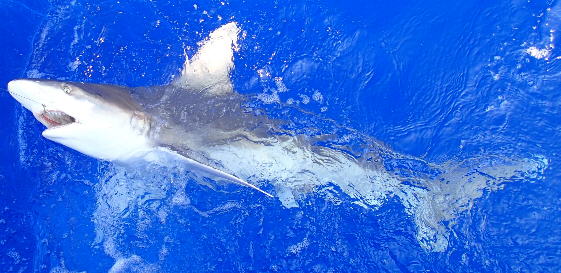Kona Hawaii Fishing Report – November wrap-up.
The striped marlin are starting to show up and right on cue. It will be interesting to see what this winters stripy run will bring because prior to 2011, we had several winters in a row with very few striped marlin showing up. In the past three winters, the stripy run has been OK but not great. Will the El Nino have an effect? Will the Billfish Conservation Act of 2012 have an effect? Only time will tell. The striped marlin are a lot smaller than the blue marlin but because these fish run in schools, hooking up several at a time is somewhat common but that will hardly ever happen with blue marlin. For years now I've been writing about how good the striped marlin meat is. If the meat is white, it's a lot like blue marlin meat but white meat is somewhat rare. The meat is usually some shade of pink and that's pretty good stuff but the best striped marlin meat is orange. I recently had a customer tell me that he went to one of our local super markets and he said that they had made up a sign showing the different colored striped marlin meat and explaining it just like I do. I've been writing about it for a long time and I guess the word got out. The blue marlin bite was pretty good this month with most catches hitting under the 200 lb. mark. There's still some spearfish being caught even though it's not really season for them. Spearfish is another good eating fish. I caught one this month and my customers packed it all back to the mainland with them.
The mahi mahi bite is good and should remain good into December. Small ahi on the buoys are an easy target but the big ones are hard to come by right now as is typical for this time of year. It's also off season for ono but I heard that there was a pretty good bite going on down by South Point.
The bottom bite has been good with finally some smooth waters to fish in. It's now peak GT (giant trevally) season and I did catch one recently but I should be catching more at this time of year. Most of my bottom fish catches have been sharks. Shark identification can be very difficult on some shark species because the differences between species can often be very minor. I recently went poking around looking at shark identifications and ran across a statement that bignose sharks are often miss-identified as sandbar sharks and visa-versa by both fishermen and marine biologists alike. The most common shark I catch is the sandbar shark. Or is it? The sandbar sharks range from shallow water to about 600' and the bignose sharks range from 100' to about 1500' so the depth that I normally bottom fish in can hold either. After reading a whole lot more about them than I cared to, and looking at lots of my old catch photos, I've come to the conclusion that I have been catching both. Mostly sandbar sharks with the occasional bignose. With a name like bignose you would think that would be the biggest characteristic but it's not. The biggest difference that's easily noticeable between these two is that the sandbar shark has a very oversized dorsal fin in comparison to its body size. More than any other shark. It should have been named the bigdorsalfin shark instead.
See 'ya on the water soon ,
Capt. Jeff Rogers ,
http://FISHinKONA.com

